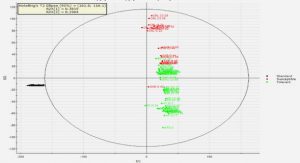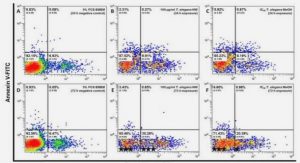Get Complete Project Material File(s) Now! »
CHAPTER 2 LITERATURE REVIEW: MEMBRANE DISTILLATION MEMBRANES FOR WATER DESALINATION
Introduction
Membrane technology has been extensively used as a separation technique to reduce the salinity of water from different sources. Additionally, membrane technology offers a relatively high rejection efficiency for particulate and dissolved organic matter from water (27). Membrane processes widely used in water desalination include reverse osmosis (RO) and nanofiltration (NF) (28). These pressure-driven processes operate at high energy requirements and operational/capital costs (29). Although NF is less energetically demanding relative to RO, this membrane process has low rejection efficiencies towards sodium and chloride (i.e., notwithstanding the fact that these monovalent ions are the main constituents of saline water) (24). Remarkably, Membrane Distillation (MD) process has been found to counteract the operational challenges of RO and NF membrane technologies. Also, due to its probable use of low grade or waste energy, MD would be a potential economically feasible technique comparable to pressure-driven membrane processes (92). The use of MD in water desalination and wastewater treatment has recently attracted the attention of numerous researchers (37,93–97). MD is a thermally-driven process in which water vapour molecules pass through a porous hydrophobic membrane. This process is enhanced by a vapour pressure induced by a temperature difference across the membrane (24), thus offering the possibility of solution saturation at the feed side without causing a significant flux decline (98). The heat energy required in the MD separation process can be generated by solar energy, geothermal energy, or waste-grade energy (99). In theory, the membranes used in MD processes should strictly allow the passage of vapours and retain non-volatile substances. Therefore, the filtrate would be close to 100% pure and devoid from solids or non-volatile contaminants (100). The performance of MD is however severely affected by two key factors: (i) wettability as a result of condensation of water vapour inside the pores of the membrane; and (ii) fouling due to the accumulation of biofilm, organic, inorganic, and colloidal substances on the surface or in the internal pore structure of the membrane (24). These two limiting factors restrict the choice of suitable polymers for the synthesis of MD membranes. Briefly, hydrophobic (i.e. with contact angle > 90° or water-hating) polymers promote hydrophobic-hydrophobic interactions between hydrophobic pollutants and the membrane surface; thus, causing blocking of the pores of the membranes and membrane fouling (57). On the other hand, hydrophilic polymers enhance the wettability of the membranes; consequently, affecting the diffusion of water vapour through the membrane and compromising its rejection efficiency (27). As a result, numerous membrane modification studies have been conducted to concurrently overcome the fouling and wettability challenges associated with MD membranes (70,101). Briefly, flat sheets, nanofibres, and hollow fibre membranes characterised by super-hydrophobicity (i.e. membranes with contact angles > 150°) have been synthesised and tested in MD applications (38–40,95,102). These superhydrophobic membranes were reported to be resistant towards wetting by process liquids. Additionally, the surface modification of MD membranes by the incorporation of nanoparticles (NPs) to further enhance their physicochemical properties has been extensively investigated (37,38,40,102–104). Several configurations and strategies for membrane distillation have been also developed over the past few decades. Even though, MD is a promising technology widely tested at a laboratory-scale, to date, its industrial implementation has been limited. Not only membrane wetting and fouling limited applications but also high CAPEX due to difficult fabrication of membrane modules.
This literature review provides a critical and comprehensive review of the state-of-knowledge regarding the MD process with insights toward better understanding its shortcomings and limitations. Additionally, recent advancements in membrane modification by the embedment of nanoparticles to enhance fouling resistance and address wettability are emphasized, and areas for further work are discussed. Furthermore, fabrication of ultraporous nanofibre membranes is included. Likewise, environmental sustainability of MD is also discussed to elucidate promising approaches for a future and successful implementation of MD at an industrial scale for the desalination of brackish water/seawater at high recovery rates. Finally, adsorption of probable foulants using nanofibre adsorbents as possible pretreatment materials is also briefly discussed.
MD membrane synthesis methods
Membrane Distillation (MD) membranes are commonly prepared using solution-casting-phase inversion and nanofibre-electrospinning methods. In the casting process, a solution of a specific material is placed on a substrate to adopt the shape of the casting material and subsequently allowed to solidify under suitable conditions (105). Figure 2.1 shows an illustration of a membrane casting procedure using a casting knife. In this process, the PVDF solution is cast on a non-woven fabric to adopt its flat shape. The membrane is then coagulated in a water bath and peeled off from the non-woven fabric. PVDF nanofibre membrane can be spin-coated using TiO2 nanoparticles to enhance the superhydrophobicity of the membrane (106). Other polymers such as PTFE and PP have been used for synthesis of MD membranes (107,108). However, PVDF has been extensively studied compared to PTFE and PP on synthesis of electrospun nanofibre membranes. PVDF is a semi-crystalline polymer mainly consisting of 59.4 wt.% fluorine and 3 wt.% hydrogen (109), and produced by free radical polymerisation leading to the formation of the –CH2–CF2– repeating units (110). The arrangements of the CH2 and CF2 bonds within the molecular chains result in the formation of a specific crystal structure leading to the formation of a polymer with unique properties. The PVDF chains can crystallise into three distinct phases (α, β, γ) depending on the fabrication technique (111). Owing to the high electrical dipole moment of these crystalline phases (112), PVDF dissolves in varied solvents (e.g., dimethyl formamide, dimethyl sulfoxide, N-methylpyrrolidone, or dimethylacetamide) (113); thus, making possible the versatile synthesis of flat-sheet, hollow-fibre, and nanofibre membranes.
The most commonly studied methods for the synthesis of MD membranes are phase inversion and electrospinning methods, involving interfacial polymerisation, graft polymerisation, and dip coating as membrane modification processes.
Phase inversion
Phase inversion is a de-mixing process whereby a homogeneous polymer solution is transformed to a solid material under controlled conditions (see Figure 2.2). This transformation process can be performed using the following techniques (29):
(i) immersion precipitation, where the polymer solution is immersed in a coagulation bath to allow the exchange of solvents to occur;
(ii) thermally induced phase separation, in which the de-mixing process occurs by subjecting the membrane to high temperatures; and
(iii) evaporation-induced phase separation, which occurs through the evaporation of the volatile solvent used to prepare the polymer solution of interest.
The phase inversion method can be applied in the synthesis of flat sheet and hollow fibre membranes. For the preparation of flat sheet membranes, the polymer solution is casted on a flat support material (e.g., glass) and subsequently immersed in a coagulating bath. The structural properties of the resulting flat sheet membrane depend on the rates of exchange of the solvent and non-solvent (115). An example of immersion precipitation phase inversion of super phosphorus (SP) and lithium iron phosphate (LiFePO4) nanoparticles-modified thermoplastic polyurethane (TPU) is illustrated on Figure 2.2. In this process, a solution of TPU and SP/LiFePO4 is casted on a flat polyfluorotetraethylene (PFTE) substrate using a casting knife. The casted solution on the substrate is placed in distilled water (coagulation bath at 25°C) to remove the solvent from the liquid-solution (de-mixing process) for 4 h. The solidified membrane is peeled-off from the substrate and dried at 100°C for 2 h (114).
The phase inversion preparation of hollow fibre membranes involves the extrusion of the polymer solution, coagulation and sintering of the coagulated hollow fibre (116). An illustration of the phase inversion preparation of hollow fibre membranes is provided in Figure 2.3. The nanocomposite membrane is prepared through a solvent transfer-induced phase separation, followed by photopolymerisation (117). Bicontinuous interfacially-jammed emulsions are used for the formation of nanoparticle-functionalised hollow fibre membranes. The ternary fluid is composed of SiO2NPs-doped monomers and the bore/sweeping fluid is water. The co-extrusion of these fluids results in the formation of hollow fibres (117). To ensure the formation of uniform hollow fibres, the nozzle of the sweeping fluid is centred, and its viscosity is adjusted by the addition of high-molecular-weight polyethylene glycol (1%). Photopolymerisation is induced by UV-light irradiation, resulting in hollow porous nanoparticle-modified membranes. The aligned hollow fibre membranes are collected in a water-filled rotating glass cylinder (117).
Electrospinning techniques
The electrospinning technique is a high voltage driven process in which the polymer solution becomes electrically charged and induces electrostatic repulsive forces when subjected to an electric field (see Figure 2.4). The polymer surface tension is broken by these forces; thus, leading to the stretching and thinning of the polymer jet (118). The electrospinning and electrospraying techniques take place simultaneously under specific controlled conditions (119). Electrospraying occurs when entanglements and molecular cohesion of the polymer solution are not strong enough to sustain stream break-down (i.e., a process where a polymer solution is ejected from the capillary nozzle and drops as a result of jet breakage) during the ejection of the polymer solution. However, under favourable molecular cohesion conditions, the droplets form charged jets, which stretch due to electrostatic forces to synthesise uniform nanofibres (120). Simultaneous electrospraying and electrospinning can lead to the formation of beaded nanofibres as a result of stream break-down (121). Electrospinning has been successfully used for the preparation of nanofibre membranes suitable for membrane distillation. The synthesis of superhydrophobic PVDF nanofibre membranes has been achieved by the incorporation of multi-walled carbon nanotubes (MWCNTs), SiO2NPs, and TiO2NPs onto polymeric membranes (e.g., PVDF membranes) resulting in contact angles higher than 150° (37,122,123). These superhydrophobic membranes are resistant to wetting by the process liquids. Not only do these modified nanofibre membranes display high contact angles, they are also characterised by a mechanical strength high enough to sustain low pressures in MD (37,122,123). These nanofibre membranes have been successfully used in the production of potable water at fluxes between 28 – 42 L•m-2•h-1 and rejection efficiencies of ~99.9%.
CHAPTER 1: INTRODUCTION
1.1 Background
1.2 Problem statement
1.3 Preliminary evaluation of water salinity and other related water contaminants in the Nandoni Dam
1.4 Aim and objectives
1.5 Research flow chart
1.6 Thesis outline
CHAPTER 2: LITERATURE REVIEW; MEMBRANE DISTILLATION MEMBRANES FOR WATER DESALINATION
2.1 Introduction
2.2 MD membrane synthesis methods
2.3 MD membrane modification methods
2.4 The use of nanoparticles in membrane modification
2.5 Commonly used configurations in MD
2.6 Applications of MD processes
2.7 Sustainability of membrane distillation
2.8 Nanofibres as potential pretreatment materials in membrane distillation
2.9 Materials used in the synthesis of polymeric nanofibre membranes
2.10 Nanofibres as adsorption materials: Pretreatment role and kinetics in MD
2.11 Conclusion
CHAPTER 3: ADSORPTION OF PHENOLIC COMPOUNDS BY POLYACRYLONITRILE NANOFIBRE MEMBRANES: A PRETREATMENT FOR THE REMOVAL OF COMPOUNDS BEARING HYDROPHOBIC GROUPS FROM WATER
3.1 Introduction
3.2 Methods and materials
3.3 Results and discussion
3.4 Conclusion
CHAPTER 4: ENHANCED FLUX IN DIRECT CONTACT MEMBRANE DISTILLATION USING SUPERHYDROPHOBIC PVDF NANOFIBRE MEMBRANES EMBEDDED WITH ORGANICALLY MODIFIED SiO2 NANOPARTICLES
4.1 Introduction
4.2 Materials and Methods
4.3 Results and discussion
4.4 Conclusion
CHAPTER 5: SYNTHESIS OF SILVER NANOPARTICLES USING ONE-POT AND MICROWAVE-ASSISTED METHODS AND THEIR SUBSEQUENT EMBEDMENT ON PVDF NANOFIBRE MEMBRANES FOR GROWTH INHIBITION OF MESOPHILIC AND THERMOPHILIC BACTERIA
5.1 Introduction
5.2 Materials and methods
5.3 Results and discussion
5.4 Conclusion
CHAPTER 6: SUPERHYDROPHOBIC PVDF NANOFIBRE MEMBRANES COATED WITH AN ORGANIC FOULING RESISTANT HYDROPHILIC ACTIVE LAYER FOR DIRECT CONTACT MEMBRANE DISTILLATION
6.1 Introduction
6.2 Materials and methods
6.3 Results and discussion
6.4 Conclusion
CHAPTER 7: RHYDROPHILIC THIN-LAYER COATING OF A SUPERHYDROPHOBIC PVDF NANOFIBRE MEMBRANE FOR ORGANIC, COLLOIDAL AND BIOFOULING MITIGATION IN DIRECT CONTACT MEMBRANE DISTILLATION
7.1 Introduction
7.2 Methods and materials
7.3 Results and discussion
7.4 Conclusion
CHAPTER 8: HYDROPHOBIC PVDF NANOFIBRE MEMBRANES COATED WITH A FOULING-RESISTANT HYDROPHILIC LAYER FOR PURIFICATION OF ENVIRONMENTAL WATER SAMPLES IN MEMBRANE DISTILLATION
8.1 Introduction
8.2 Methods
8.3 Results and discussion
8.4 Conclusion
CHAPTER 9 GENERAL CONCLUSIONS AND RECOMMENDATIONS
REFERENCES
APPENDICES
GET THE COMPLETE PROJECT






